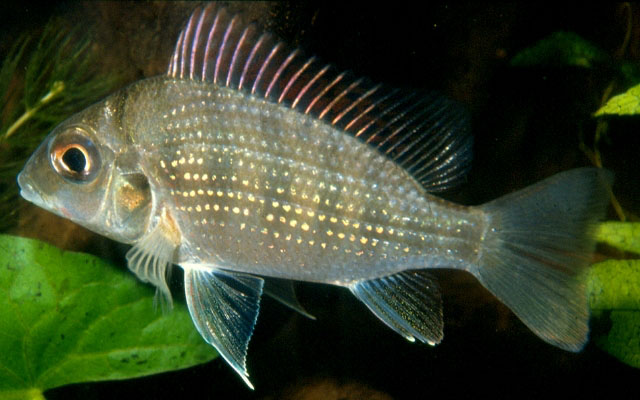| Cichlidae (Cichlids), subfamily: Pseudocrenilabrinae |
| 26 cm TL (male/unsexed) |
|
benthopelagic; freshwater |
| Africa: from the lower Congo River just below Pool Malebo (=Stanley Pool) throughout the middle Congo River basin up to the Wagenia Falls, including Pool Malebo, middle Congo River, the Kasai drainage, lakes Mai-Ndombe and Tumba, the Ruki, Sangha and Aruwimi (Ref. 52346). Also in the Aruwimi and Lindi-Tshopo (Ref. 106290). Also reported from the Ubangi (Ref. 45441) but this drainage is explicitly excluded from the species' distribution area in Ref. 52346. |
|
Dorsal spines (total): 13-16; Dorsal soft rays (total): 12-15; Anal spines: 3-3; Anal soft rays: 7-8; Vertebrae: 28-30. Diagnosis: 35 or fewer lateral line scales; 17 gill-rakers along lower limb of first arch; inferior vertebral apophysis with characteristic spade-like outline; lower pharyngeal jaw never very robust or mill-like; molariform dentition rarely covers half of the dentigerous surface; posstempral latero-sensory canal not fully ossified and trough-like; pectoral fins long, usually reaching the anal fin (Ref. 52346).
Description: deep-bodied with very steep cranial profile (Ref. 52307). Pronounced dorsal curvature (predorsal profile straight and steep, rising uninterrupted from the snout to the dorsal fin origin) and ventral flattening; deepest body depth along the back reached behind the dorsal fin origin to about the fourth or fifth dorsal spine; lower jaw more or less horizontal when mouth is closed; lower pharyngeal jaw never very robust or mill-like; molariform dentition rarely covers half of the dentigerous surface (Ref. 52346). Cheek with 3-4 series of scales (Ref. 52971). Posttemporal latero-sensory canal not fully ossified and trough-like; 16-18 gill-rakers along lower limb of first arch; first 2-3 hypobranchial rakers simple and often hooked; intervening ceratobranchial rakers broad, crenate and overlapping each other; 9-10 fine, elongate epibranchial rakers; inferior vertebral apophysis with characteristic spade-like outline; 32-35 lateral line scales (Ref. 52346). 5-6 scales between first dorsal spine and upper lateral line; 2 scales between lateral lines (Ref. 52971). Scales cycloid (Ref. 53265). Upper branch of lateral line ends a little in advance of the soft dorsal below the antepenultimate or fourth soft ray; dorsal and ventral branches of lateral line on the caudal fin are well-developed and extend almost to the fin periphery, the median branch is somewhat shorter and usually extends about 2/3 of the fin length; dorsal fin spines increase in length gradually to the fifth and are then more or less equal in length; anal fin rounded; pectoral fins long, frequently reaching well beyond the level of the vent and often extending to the level of the second anal spine in larger individuals; first branched pelvic ray frequently produced and filamentous, but not often reaching the level of the soft anal fin; caudal fin roundly emarginate and finely scaled to the periphery (Ref. 52346).
Coloration: gray to gray-brown body; most body scales with silvery center; two dark bars between eyes and origin of dorsal fin (Ref. 52307). Upper half of body with traces of 7-8 transversal bands, with the first one between the eyes and the second one between eyes and dorsal fin origin(Ref. 52346). Usually large number of dark spots on dorsal fin, and outer margin often red (Ref. 52307). Dorsal fin with alternating dark and light horizontal stripes, which are replaced by series of dots in male specimens which also have dark spots on the caudal fin (Ref. 52346). Lower section of caudal fin sometimes reddish (Ref. 52307). Preserved material often bleached a uniform light brown leaving only the faintest traces of a nape band; opercular blotches and traces of 5-6 vertical stripes sometimes present; some juvenile specimens have 5-6 vertical stripes interdigitated by short bars extending from the base of the dorsal fin over 2 or often 3 scale rows (Ref. 52346). Freshly caught specimens reported to have a greenish-yellow body, sometimes with reddish flecks on the lower flanks, sometimes with a scarlet red flash behind the angle of the jaws and a smaller red spot on the operculum; adults have a spotted dorsal fin with red lappets between the spines, and the caudal fin exhibited divided coloration, greenish above and reddish below; black spots or streaks are sometimes present on the caudal fin (Ref. 45434). |
| Benthic macrophage (Ref. 52346). Feeds mainly upon insect larvae, plants and fruits, as well as detritus and molluscs (Ref. 52307, 52346). Maternal (Ref. 52307) mouth brooder (Ref. 51193) that does not pair bond (Ref. 52307). Tastes like Nile perch, Lates niloticus (Ref. 51906). |
|
Least Concern (LC); Date assessed: 16 February 2009 Ref. (130435)
|
| harmless |
Source and more info: www.fishbase.org. For personal, classroom, and other internal use only. Not for publication.

